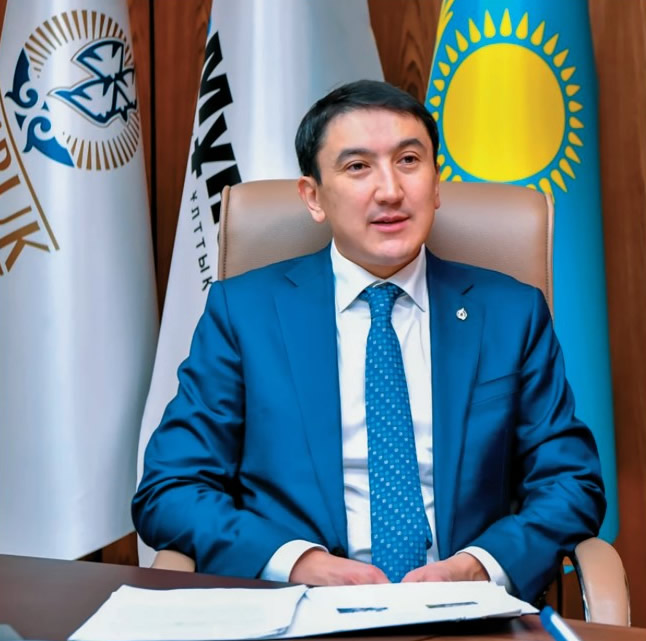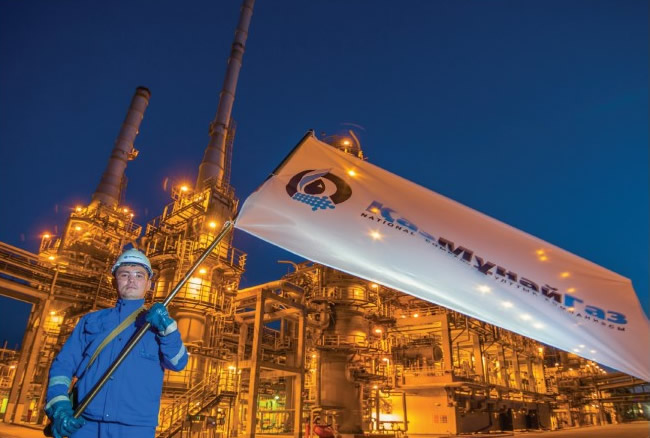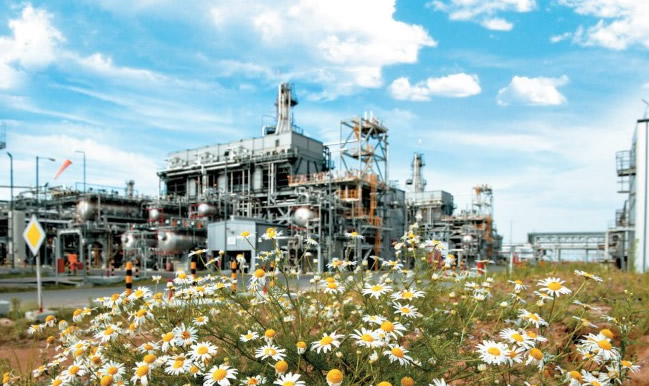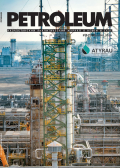Atyrau Oil & Gas
The Future of KMG: Focusing on Exploration, Petrochemicals, and Sustainable Development

The Atyrau and Mangystau regions are the key areas of operation for the national company KazMunayGas, which engages in oil extraction and processing and conducts maritime transportation from the port of Aktau. In an interview with the press service, KMG's Chairman of the Board, Magzum Mirzagaliyev, summarizes the company's achievements over the 22 years since its establishment and discusses the future development of the business: from exploration to petrochemicals and diversifying oil transportation routes.
- When KazMunayGas was founded in 2002, the goal was to transform it into the national oil and gas market operator. To this end, a vertically integrated system based on the assets that KMG received from the state was necessary. You have led the company since April 2022 and worked in it in previous years. Share your observations and tell us about how KMG's current structure was created.
- KazMunayGas was established through the merger of the national oil and gas company Kazakhoil and the national company Oil and Gas Transport. These were not always related assets, and unifying them into a vertically integrated system was necessary. At that time, from Kazakhoil’s legacy in terms of extraction assets, Uzenmunaigas and Embamunaigas became part of KMG. After that, KMG acquired stakes in other oil and gas extraction projects, such as Mangistaumunaigaz, Kazakhoil Aktobe, Karazhanbasmunai, and others. We are also shareholders in mega-projects like Tengiz, Karachaganak, and Kashagan.
In addition, KazMunayGas and partners (Kazakhstan-China Pipeline, Munaitas, and Caspian Pipeline Consortium) are involved in transporting 100% of Kazakhstani oil. This is carried out through the pipeline system of KazTransOil and by tankers of our maritime shipping company, Kazmortransflot. Today, KMG owns seven oil tankers: Astana, Almaty, and Aktau (deadweight of 12 thous. tons), Aframax tankers – Alatau and Altai (deadweight of 115 thous. tons), and, additionally, in 2023, together with Abu Dhabi Ports Group, we acquired two more – Taraz and Liwa (deadweight of 8 thous. tons).
Over 22 years, we have also expanded our assets in oil processing. If today, KMG owns three oil refineries in Kazakhstan, at the time of the company’s founding, it had only one – the Atyrau Refinery. Later, KMG acquired the Pavlodar plant and a stake in the Shymkent Refinery and built the Caspi Bitum plant in Aktau with a Chinese partner. Over these years, oil refining assets in Romania were also acquired.
Looking back, we can confidently say that today, KazMunayGas encompasses the entire spectrum of oil and gas activities in its structure, from exploration and extraction to transportation and refining of oil.
- Today, in 2024, KazMunayGas continues to develop its business…
- The last year was marked by positive and joyful events for us. I'll start with transportation. Thus, in January 2023, we created a joint venture with partners from the United Arab Emirates, Abu Dhabi Ports Group (ADP), and acquired two tankers—the already mentioned Taraz and Liwa. They are involved in transporting Kazakhstani oil in the Caspian Sea.
Furthermore, since the middle of last year, we began for the first time the transportation of Tengiz oil in open seas, a task historically undertaken solely by Chevron Tankers Ltd. Today, the joint KMG/ADP tanker pool (four Aframax tankers, two of which belong to KMTF, and two to ADP) is already transporting oil from the Tengiz field from the seaport of Novorossiysk and further around the world.
We are interested in and eager to expand our Aframax fleet. We want to increase it: Today, we have four tankers and plan to expand to twelve. This is a complex and slow process. They need to be ordered and found on the market, which is what we are currently engaged in. Over the next few years, we expect to grow our fleet to 12 Aframax tankers, allowing us to transport at least half of the Tengiz oil.

- In the second half of 2022, Kazakhstan began actively diversifying its oil export routes. KazMunayGas became one of the main players in this process and quickly started addressing the task.
- The head of the state set the task of developing the so-called Middle Corridor (Trans-Caspian International Transport Route), which includes transportation across the Caspian Sea. Last year, we began transporting oil toward Baku and through the Baku-Tbilisi-Ceyhan pipeline as part of this route. Our plans include increasing the transportation volumes along this route. This by no means suggests that we are seeking an alternative to the Caspian Pipeline Consortium pipeline. CPC remains a reliable, stable, and, most importantly – the fastest route for delivering our oil to export markets.
Last year, we also began transporting oil toward Germany. By the end of 2023, we transported almost 1 million tons of oil to this country, and we expect to exceed this volume this year.
If we continue on the topic related to oil trade, I think an important event, not only in the life of the company but also in the entire oil and gas industry of Kazakhstan, is the launch of the Kazakh oil brand KEBCO – Kazakh Export Blend Crude Oil. Historically, Kazakhstan traded two grades of oil: CPC – a blend of oil in the CPC pipeline, and Urals – a grade of various oils mixed in the Atyrau-Samara pipeline. In the case of Urals, Kazakhstani oil is mixed with Russian during transportation to Russian seaports. Therefore, it was sold under the Urals brand.
Starting in 2022, the discount on the Urals became quite significant. Consequently, we decided to promote our Kazakhstani oil brand, KEBCO, in the markets. When we first entered the market with this oil grade at the end of 2022, it was sold at a discount of around minus $15-18 to Brent. In 2024, KEBCO already trades Brent at a $2-2.5 premium. This has positively reflected on the economy of our company and other private Kazakhstani companies and, overall, on the recognition of Kazakhstan.
- Continuing the discussion on the development of the company's business... KMG is actively involved in creating a petrochemical cluster in Kazakhstan. Can we say that petrochemicals will become a significant source of income for KMG at some point? Will the margins for petrochemicals be even higher than for petroleum products?
- I believe petrochemicals should become an additional source of income not only for KMG. The development of petrochemicals, or what we call basic chemistry, should stimulate the growth of small and medium-sized enterprises (SMEs). This is very important!
Thus, at the end of 2022, a polypropylene production plant was launched with the participation of the head of state in the Atyrau region. In October last year, the enterprise reached its planned production volumes. It is extremely important for us that as much of our polypropylene as possible remains in Kazakhstan so that we can create dozens of small- and medium-sized productions.
We are primarily talking about representatives of SMEs: manufacturers of bags, packaging, pipes, automotive parts, household utensils, etc. In this regard, we regularly meet with polypropylene buyers—small and medium-sized businesses. Earlier, we organized a forum and invited SME representatives to visit our plant to see polypropylene production firsthand.
To date, we have more than 40 polypropylene buyers in Kazakhstan, to whom we have already started supplying products. Understandably, enterprises need to "get accustomed" to our product. However, by the end of last year, polypropylene imports into Kazakhstan decreased by 42%. We believe we will cover this demand this year, and imported polypropylene will no longer be brought into the country or reduced to minimal volumes. Meanwhile, our polypropylene is also exported to various countries: China, Turkey, Europe, and Russia.
The next stage in the development of the petrochemical complex is constructing a polyethylene plant. Initially, KMG developed the project in collaboration with SIBUR. It's pleasing to note that last autumn, we signed an agreement for another partner, Chinese Sinopec, to join our project. Currently, necessary corporate approvals are being sought from the Chinese partner. We expect the deal to be formalized shortly. After that, the shares in the project will be distributed as follows: 40% - KMG, 30% - SIBUR, and 30% - Sinopec.
Polyethylene is a landmark project. We plan to produce 1.25 million tons annually. There are few analogs to such a complex. It will consist of two polymerization units (licensors—American companies): one using Chevron Phillips technology to produce high-margin, high-tech polyethylene, and the other from Univation for a more mass-produced product. Each unit will produce 625,000 tons of polyethylene per year. As for engineering, companies involved include German Linde, Spanish Tecnicas Reunidas, Italian Tecnimont, and many others.
We are not limiting ourselves to the aforementioned projects and are in search of new directions.
For instance, the Atyrau Refinery today produces paraxylene, which is entirely exported abroad. From our paraxylene, they produce terephthalic acid (TPA) and polyethylene terephthalate (PET)—the raw material for producing plastic bottles, sports fabrics, synthetic fillers, etc. Accordingly, we questioned why we did not process paraxylene in our country instead of exporting it. Therefore, we have started developing a feasibility study, based on which we will hopefully decide to construct such a plant in Kazakhstan.
- In our recent discussion, we delved into strategic matters, and I'd like to revisit the foundation of our company – oil extraction and exploration. Since its inception, the company has gradually expanded its resource base, primarily through the acquisition of production assets and participation in mega-projects (Tengiz, Karachaganak, Kashagan). This strategy has provided the company with ample oil reserves, yet active exploration was not pursued. However, exploration now represents one of the company's strategic tasks…
- As a former Minister of Ecology, Geology, and Natural Resources, I'm aware that only 24% of our subsoil has been explored. Kazakhstan has 15 sedimentary basins, with the Caspian Sedimentary Basin being the largest. Our geologists believe significant discoveries are still to be made in Kazakhstan. Exploration is a crucial task, and the successful execution of it will allow the company to develop steadily for many years. KazMunayGas is primarily an oil and gas company, and we need to increase reserves and discover new fields. Unfortunately, we must acknowledge that no significant discoveries have been made in recent years. We have increased our reserves mainly by further exploring existing fields.
In 2022, we identified five areas for geological subsoil investigation: Mugodzhary in the Aktobe region, Berezovsky in the West Kazakhstan region, and several sites in the Mangystau region. The company has allocated a budget for this purpose for 2023-24. In 2024, we will complete seismic work and the interpretation of geological information for these sites. It's encouraging to note the interest from potential partners. Our current task is to conduct preliminary work, invite private investors, and jointly commence exploration activities on these sites. We believe in the high potential of our subsoil!
Moreover, KMG plans to drill three exploratory wells this year. We plan to drill one well in the Kyzylorda region at the Turgai Paleozoic site, where equipment mobilization is already underway. We aim to start this work by mid-year. Without making any predictions, we naturally have certain expectations. Also, in 2024, we plan deep subsalt drilling at the Karaton Subsalt structure in the Atyrau and Mangystau regions. Additionally, this year, we plan to drill a well in partnership with Eni at the Abai site in the Caspian Sea.
I'd also like to touch on KMG's new extraction projects. Last year, we established a joint venture with Lukoil for the Kalamkas-sea, Khazar, Auezov project in the Caspian Sea. Active work has begun, and an operational company based in Aktau has formed. We plan to start oil production in 2028-29. This is a significant and symbolic project for us, enabling oil extraction and creating new jobs in the Mangystau region, which is extremely important.
- Will KMG's planned onshore drilling in the coming years be at greater depths?
- Yes, for example, the Karaton Subsalt area. We are planning a depth of up to 5,500 meters for this well. For the Turgai Paleozoic site, we also plan to reach greater depths – 5,500 meters.
We believe that significant discoveries could be made at these depths. However, this is undoubtedly associated with higher risks, requiring more complex drilling and the latest technologies. These are new challenges for KazMunayGas.

- Is the company ready to undertake exploration at its own expense now?



